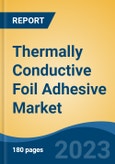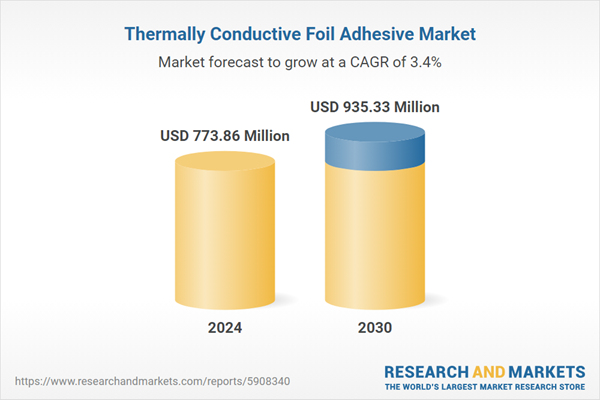Speak directly to the analyst to clarify any post sales queries you may have.
10% Free customizationThis report comes with 10% free customization, enabling you to add data that meets your specific business needs.
Thermally Conductive Foil Adhesive Market was valued at USD 773.86 Million in 2024 and is expected to reach USD 935.33 Million by 2030 with a CAGR of 3.39%. The global adhesive industry is a dynamic and evolving sector that serves as a critical component in various applications across industries. Among the specialized adhesive products, thermally conductive foil adhesives have gained prominence due to their unique ability to transfer heat efficiently while providing strong bonding properties. The rapid evolution of the electronics industry, characterized by shrinking device sizes and increasing power densities, has created a need for efficient heat dissipation. Thermally conductive foil adhesives enable the effective transfer of heat away from electronic components.
As electronic devices become smaller and more compact, managing heat generated by densely packed components becomes a significant challenge. Thermally conductive foil adhesives play a vital role in dissipating heat, ensuring the reliability and performance of miniaturized electronics. Industries such as automotive and aerospace are under pressure to improve energy efficiency while maintaining high-performance standards.
Thermally conductive foil adhesives are utilized in these sectors to enhance thermal management and contribute to energy savings. Achieving effective adhesion to a wide range of substrates, including metals, ceramics, and plastics, poses a challenge for thermally conductive foil adhesives. Tailoring adhesive formulations to ensure compatibility with specific materials is essential. As electronic devices become smaller and more intricate, ensuring precise application and uniform thickness of thermally conductive foil adhesives can be technically challenging.
The market is expected to witness a growing demand for sustainable and environmentally friendly thermally conductive foil adhesives. Adhesive manufacturers will continue to explore formulations that reduce environmental impact. As electronic devices continue to evolve, thermally conductive foil adhesives will play a pivotal role in advanced thermal management solutions. These adhesives will need to deliver higher thermal conductivity and improved durability. The growing adoption of electric vehicles is expected to drive demand for thermally conductive foil adhesives in the automotive sector, particularly for battery thermal management to ensure safe and efficient operation.
The global thermally conductive foil adhesive market is positioned as an essential contributor to various industries, ensuring efficient heat management and thermal dissipation in electronic devices, automotive applications, and more. As industries continue to prioritize energy efficiency, miniaturization, and thermal performance, thermally conductive foil adhesives will remain a critical element in advancing technological capabilities. To excel in this dynamic market, adhesive manufacturers should prioritize innovation, with a focus on sustainability, advanced thermal conductivity, and material compatibility. As technology continues to evolve and industries seek solutions for efficient thermal management, the role of thermally conductive foil adhesives in shaping the future of electronic devices and thermal applications is expected to remain pivotal.
Key Market Drivers
Growing Advancement in Electronic Industry is Major Factor for Thermally Conductive Foil Adhesive Market Growth
The global thermally conductive foil adhesive market is experiencing significant growth, primarily driven by the continuous advancement in the electronic industry. The electronic industry is characterized by rapid innovation, with manufacturers constantly seeking ways to enhance the performance and reliability of electronic components and devices. Efficient heat dissipation is a critical concern in electronics manufacturing. As electronic devices become more powerful and compact, managing heat generation is essential to ensure their longevity and reliability. The rapid expansion of the consumer electronics industry, with global demand for electronic products projected to double by 2050, is driving the need for advanced thermal management solutions. This surge in electronic device production directly supports the growing adoption of thermally conductive foil adhesives, which are essential for efficient heat dissipation and maintaining the performance and reliability of increasingly compact and high-powered electronic components.Thermally conductive foil adhesives play a vital role in electronic applications by providing both thermal conductivity and adhesive properties. They facilitate the efficient transfer of heat away from electronic components to ensure proper functioning. With the increasing demand for smaller and more powerful electronic devices, there is a growing need for effective heat management solutions to prevent overheating and component failure. Thermally conductive foil adhesives are designed to bond various electronic components, including heat sinks, LEDs, integrated circuits (ICs), and power modules, to heat-spreading substrates such as metal, ceramic, or printed circuit boards (PCBs).
The electronic industry requires precise and reliable thermal solutions. Thermally conductive foil adhesives provide consistent and efficient heat transfer while ensuring the structural integrity of electronic assemblies. Ongoing research and development efforts in the adhesive industry have led to advanced formulations of thermally conductive foil adhesives. These formulations offer improved thermal conductivity, adhesion strength, and resistance to environmental factors. The growing advancement in the electronic industry's demand for efficient heat management solutions is driving the need for specialized thermally conductive foil adhesives. Electronics manufacturers seek adhesives that can dissipate heat in allowing for the development of more powerful and compact electronic devices.
The global thermally conductive foil adhesive market is experiencing robust growth, primarily driven by the continuous advancement in the electronic industry. These adhesives have become indispensable in the electronic manufacturing process, ensuring efficient heat management and the reliability of electronic components and devices. As the electronic industry continues to innovate and evolve, the market for thermally conductive foil adhesives is expected to thrive. Manufacturers and suppliers in this market must continue to innovate and provide high-quality solutions to meet the evolving demands of the electronic industry, ensuring continued growth and the development of cutting-edge electronic devices worldwide.
Key Market Challenges
Miniaturization Complexity
The global thermally conductive foil adhesive market faces a significant impediment in the form of miniaturization complexity. As electronic devices continue to shrink in size while simultaneously increasing in complexity and power, the demand for efficient heat management solutions has surged. Thermally conductive foil adhesives play a vital role in dissipating heat from electronic components to prevent overheating and ensure optimal performance.However, miniaturization introduces complexities in the design and application of these adhesives. Smaller components mean tighter spaces, making it challenging to apply and secure thermally conductive foils effectively. Ensuring precise alignment and uniform adhesive coverage in these confined areas becomes a technical challenge.
To address this, manufacturers in the thermally conductive foil adhesive market must invest in research and development to create adhesive solutions that are compatible with miniaturized electronics. This includes formulations that offer exceptional thermal conductivity while also being flexible, easy to handle, and resistant to environmental factors. By meeting the demands of miniaturization complexity, the market can provide reliable solutions for the evolving electronics industry and drive its growth.
Key Market Trends
Advanced Thermal Management
Advanced thermal management techniques have emerged as a key trend driving the growth of the global thermally conductive foil adhesive market. In today's technology-driven world, electronic components are becoming increasingly powerful and compact, generating higher levels of heat. Efficient heat dissipation is crucial to ensure the reliability and longevity of these components.Thermally conductive foil adhesive plays a vital role in thermal management solutions. These adhesives are designed to bond heat sinks, thermal interface materials, and foil tapes to electronic components, effectively conducting and dissipating heat away from sensitive areas. This enables better temperature control, preventing overheating and potential damage to electronics.
As industries like electronics, telecommunications, and automotive continue to demand smaller, more powerful devices, the need for advanced thermal management solutions grows. Thermally conductive foil adhesives that offer excellent thermal conductivity and adhesive properties are in high demand. Companies that innovate and provide these advanced adhesive solutions are poised to benefit from this trend, contributing to the development of more efficient and reliable electronic systems.
Key Market Players
- Fischer Elektronik
- AMEC Thermasol
- Katecho Inc
- 3M Company
- Teraoka Seisakusho Co Ltd
- Can-Do National Tape (Tape Holding Co Inc)
- Dexerials Corporation
- Nitto Denko Corp
- T-Global Technology
Report Scope:
In this report, the Global Thermally Conductive Foil Adhesive Market has been segmented into the following categories, in addition to the industry trends which have also been detailed below:Thermally Conductive Foil Adhesive Market, By Type:
- One Side
- Two Side
- Other
Thermally Conductive Foil Adhesive Market, By Application:
- Computer
- Communication
- Industry
- Medical Care
- Others
Thermally Conductive Foil Adhesive Market, By Region:
- Asia-Pacific
- China
- India
- Japan
- Australia
- South Korea
- North America
- United States
- Canada
- Mexico
- Europe
- France
- United Kingdom
- Italy
- Germany
- Spain
- South America
- Brazil
- Argentina
- Colombia
- Middle East & Africa
- South Africa
- Saudi Arabia
- UAE
- Kuwait
- Turkey
- Egypt
Competitive Landscape
Company Profiles: Detailed analysis of the major companies present in the Global Thermally Conductive Foil Adhesive Market.Available Customizations:
With the given market data, the publisher offers customizations according to a company's specific needs. The following customization options are available for the report.Company Information
- Detailed analysis and profiling of additional market players (up to five).
This product will be delivered within 1-3 business days.
Table of Contents
Companies Mentioned
The leading companies profiled in this Thermally Conductive Foil Adhesive market report include:- Fischer Elektronik
- AMEC Thermasol
- Katecho Inc
- 3M Company
- Teraoka Seisakusho Co Ltd
- Can-Do National Tape (Tape Holding Co Inc)
- Dexerials Corporation
- Nitto Denko Corp
- T-Global Technology
Table Information
| Report Attribute | Details |
|---|---|
| No. of Pages | 180 |
| Published | September 2025 |
| Forecast Period | 2024 - 2030 |
| Estimated Market Value ( USD | $ 773.86 Million |
| Forecasted Market Value ( USD | $ 935.33 Million |
| Compound Annual Growth Rate | 3.3% |
| Regions Covered | Global |
| No. of Companies Mentioned | 10 |









